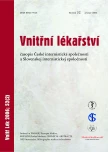Mutational analysis of LQT genes in individuals with drug induced QT interval prolongation
Authors:
T. Novotný 1; J. Kadlecová 2; I. Papoušek 3; K. Chroust 3; A. Bittnerová 2; A. Floriánová 1; E. Češková 4; M. Weislamplová 1; V. Pálenský 4; M. Šišáková 1; O. Toman 1; R. Gaillyová 2; J. Špinar 1
Authors‘ workplace:
Interní kardiologická klinika Lékařské fakulty MU a FN Brno, pracoviště Bohunice, přednosta prof. MUDr. Jindřich Špinar, CSc., FESC
1; Oddělení lékařské genetiky FN Brno, pracoviště Fakultní dětská nemocnice J. G. Mendla, přednosta prim. MUDr. Renata Gaillyová
2; Katedra genetiky a molekulární biologie Přírodovědecké fakulty MU Brno, vedoucí prof. RNDr. Jiří Doškař, CSc.
3; Psychiatrická klinika Lékařské fakulty MU a FN Brno, pracoviště Bohunice, přednosta prof. MUDr. Eva Češková, CSc.
4
Published in:
Vnitř Lék 2006; 52(2): 116-118
Category:
Original Contributions
Overview
Background:
In a long list of non-cardiovascular drugs a risk of QT interval prolongation and thus an increased risk of malignant arrhythmias has been described. The precise mechanism remains unclear. Many of these drugs are potent blockers of cardiac ion channels. Thus, prolongation of repolarization could be caused by latent ion channel genes mutations which are revealed under stress conditions.
Group of patients and methods:
Patients were recruited in screening of antipsychotic drugs with proarrhythmic potential, another sporadic cases were reffered from regional hospitals. In 13 individuals pathologic values of corrected QT interval (> 0.44 s in males, > 0.46 s in females) were observed. Eleven patients gave their consent to mutational analysis of KCNQ1, KCNH2, SCN5A, KCNE1, KCNE2 and KCNJ2 genes (associated with congenital long QT syndrome).
Results:
At present complete results of mutational analysis are available in 8 patients. In 5 individuals changes in DNA sequence were found which are considered normal variants according to the literature (nucleotide and aminoacid polymorphisms, intronic variants). In 1 male a KCNQ1 gene mutation A590T was identified (yet not reported in literature).
Conclusion:
Mechanisms of drug-induced QT interval prolongation is complex and it cannot be explained simply by ion channel disorders.
Key words:
gene - ion channel - mutation - proarrhythmia - QT interval
Sources
1. Clancy CE, Kurokawa J, Tateyama M et al. K+ channel structure-activity relationships and mechanisms of drug induced QT prolongation. Annu Rev Pharmacol Toxicol 2003; 43 : 441-461.
2. European Agency for the evaluation of Medicinal Products. Human Medicines Evaluation Unit. The Committee for Proprietary Medicinal Products (CPMP). Points to consider: The assessment of the potential for QT interval prolongation by noncardiovascular medicinal products. March 1997 (CPMP/986/96).
3. Evans WE, McLeod HL Pharmacogenomics - drug disposition, drug targets and side effects. N Engl J Med 2003; 348 : 538-549.
4. Fenichel RR, Malik M, Antzelevitch C et al. Independent Academic Task Force. Drug-induced torsades de pointes and implications for drug development. J Cardiovasc Electrophysiol 2004; 15 : 475-495.
5. Haverkamp W, Breithardt G, Camm AJ et al. The potential for QT prolongation and pro-arrhythmia by non-anti-arrhyhtmic drugs: clinical and regulatory implications. Report on a Policy conference of the European Society of Cardiology. Cardiovasc Res 2000; 47 : 219-233.
6. Napolitano C, Schwartz PJ, Brown AM et al. Evidence for a cardiac ion channel mutation underlying drug-induced QT prolongation and life-threatening arrhythmias. J Cardiovasc Electrophysiol 2000; 11 : 691-696.
7. Novotný T, Florianová A, Češková E et al. Monitorace intervalu QT u pacientů léčených psychofarmaky. Cor Vasa 2005; 47(Suppl): 75.
8. Priori SP, Rivolta I, Napolitano C. Genetics of long QT, Brugada, and other channelopathies. In: Zipes DP, Jalife J (eds). Cardiac electrophysiology: from cell to bedside. 4th ed. Philadelphia: WB Saunders 2000 : 462-470.
9. Semrád B. Od selhání antiarytmik k pochopení fenoménu proarytmie. Vnitř Lék 2003; 49 : 700-706.
10. Sesti F, Abbot GW, Wei J et al. A common polymorphism associated with antibiotic-induced cardiac arrhythmia. Proc Natl Acad Sci USA 2000; 97 : 10613-10618.
11. Yang P, Kanki H, Drolet B et al. Allelic variants in long-QT disease genes in patients with drug-associated torsade des pointes. Circulation 2002; 105 : 1943-1948.
Labels
Diabetology Endocrinology Internal medicineArticle was published in
Internal Medicine

2006 Issue 2
Most read in this issue
- Idiopathic premature ventricular complexes - catheter ablation as a therapeutic alternative
- The role of transesophageal echocardiopgraphy in detection of cardiogenic and aortic sources of embolism in stroke and transient ischaemic attacks
- Can we cure atrial flutter with radiofrequency ablation in an hour?
- Osteonecrosis of the jaw in the course of multiple myeloma treatment and bisphosphonate administration
